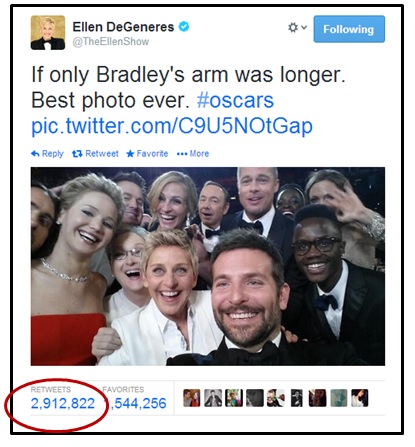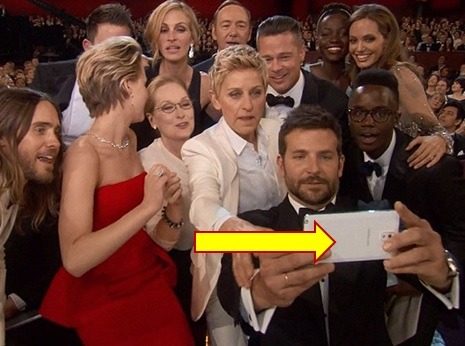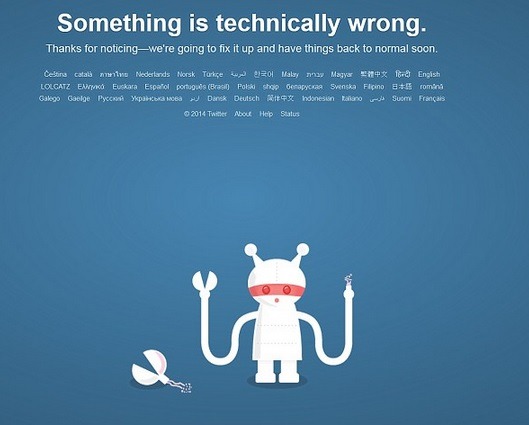 While most of us were watching the Oscars to see if a favorite movie, actor, or actress walked away with a coveted gold statue, Lori Lewis had her eyes glued to all her electronic gadgets and devices, hoping to capture and better understand the confluence of a big TV real-time event, social media, and a massive audience. Sure enough, it happehed. Here’s Lori’s “Oscar Moment” and what it means. – FJ
While most of us were watching the Oscars to see if a favorite movie, actor, or actress walked away with a coveted gold statue, Lori Lewis had her eyes glued to all her electronic gadgets and devices, hoping to capture and better understand the confluence of a big TV real-time event, social media, and a massive audience. Sure enough, it happehed. Here’s Lori’s “Oscar Moment” and what it means. – FJ
As WMMR Program Director Bill Weston said to me in an email exchange about The Oscar’s Sunday night, “Social media – for a moment – trumped the 40 million plus people watching it on TV.”
And he’s right.
But what most don’t know is that the “best selfie ever” was somewhat preplanned with a strategy between the Academy, Samsung, and host Ellen DeGeneres.
And here’s how it worked.
What we used to call product placement has morphed into “native advertising moments.” Ellen was expected to casually whip out her Samsung a couple times live on air during her monologue and create one of these events on her phone. And she didn’t let the sponsor down.
But the thing that stood out to me is that prior to that outsized “group selfie shot” seen around the world, she actually took earlier selfies – some live on air. The difference with these other selfies is that she simply took the pictures and tweeted them in a low-key way.
She didn’t use the power of a call to action, along with the TV airwaves. She just simply took this shot of herself live on stage…and it garnered over 171,000 retweets.
Not bad, right? But at some point, Ellen realized the full potential of a traditional network audience on a big night, and how it could turbocharge her next planned “Samsung selfie.”
And you knew it was going to be big the moment Ellen said live on TV, “Let’s make this the most retweeted tweet of all time on Twitter.” And that’s when I sensed something big was about to happen.
There was the marketing trifecta, an event with millions of viewers, the power of Twitter, and the simple call to action:
 Nearly 3 million people have retweeted that goofy group selfie!
Nearly 3 million people have retweeted that goofy group selfie!
It took just short of two hours for Ellen’s effort to finally blow by President Obama’s re-election tweet from 2012 that currently held the record for most retweets, with over 780,000 shares – which sounds so small now.
Within minutes of surpassing Obama’s twee, Ellen’s selfie was being retweeted by the millions, leading to Twitter sporadically crashing:
Samsung was happy, and the Academy had to be glowing with this moment that we’re still talking about two days later. Overall, viewership was up 9% this year compared to last year’s Oscars. And the amount of people participating on Twitter was way up, too. In 2013 during the live Oscars show (8:30 p.m.-12:00 midnight ET), there were more than 8.9 million tweets around the world containing terms related to the telecast. This year, there were over 14.9 million tweets during the live show.
Overall, this moment could serve as a real life media lesson in understanding the influence we can have when we’re strategic with our brand, our clients, and Twitter.
And when you truly put a plan in place on the Twitter platform, incredible moments like this one have the potential to happen. Yet, the key is in having a strategy and also having fun.
I am often asked by clients how they can monetize social media. And of course, the conversation inevitably moves to the number of “likes” or “followers.” But spamming your social audience, pushing out unwanted messages to them, not acknowledging them, and cutting them out of the process never really works in a successful, sustainable way.
And this Oscar, Samsung, Ellen moment produced another winner. Since Twitter went public, many have questioned whether the platform can truly be a successful advertising and marketing medium. Yes, Samsung might have won the Best Supporting Oscar, but Twitter may have taken Best In Show with one click of a smartphone and a couple of hashtags.
On Sunday night, the Academy (yes, the stick-in-the mud Academy), Samsung, and a host who has an innate sense of herself and her audience took a leap, captured a moment, and made it fun for millions.
That’s not just a “native advertising moment.”
It’s a true megawatt, viral explosion.
And it’s proof positive of the power of social media for great brands.






So here’s the question – how much benefit did Samsung really get from this? Two thirds of the trifecta you mention were the Oscars (mega international event with a long history and high recognition) and Ellen (a personality people absolutely love). While this was an amazing, funny, interactive moment (I re-tweeted it, too) I would love to see a post analysis on Samsung recognition and sales. Your point about strategy is well taken – this was brilliantly planned and seemed spontaneous. But in the overall picture did most people think they were just using a smartphone or that Samsung was THE phone to use for this.
We cannot deny the potential effect of social media on brand awareness but it is difficult to extrapolate to a local level based on a mega event like this. This was a perfect storm of event, personality and product. How can a local business arrange something like that? A path worth taking but one made more difficult without a massive budget.
In the end it starts with an idea followed by the commitment to execution. Perhaps that is the takeaway for radio.
A follow-up. Samsung did get a lot of mentions, which surprises me: https://www.adweek.com/news/technology/ellens-selfie-scores-oscar-gold-samsung-156061
I think that your last sentence, Steve, says it all. While not everyone might connect the stunt to Samsung, their commercials within the Oscars show probably helped that recall along. And so it’s about truly integrated campaigns – not just buying a spot schedule. The combination of the Ellen selfie and the ads Samsung ran during the show come together to create a successful venture, with the afterglow of social media to keep it alive days later.
For radio, this means working harder to integrate advertisers into formats and shows, utilizing the assets that stations own – events, stunts, promotions, features, DJs. Simply running a commercial (in a cluster with 8-10 others) has lost its potency. As advertisers look for more ROI and “accountability,” the pressure falls to sales reps, PDs, and talent to find ways to connect these dots – without compromising programming.
Of course, it’s harder! But that’s the cost of doing business in traditional media in 2014. Thanks for the comment.
Hi Steve, Always good to hear from you. While Samsung, no doubt, will work on a post analysis on recognition and sales – we shouldn’t be so quick as outsiders to tear down moments (like Sunday night) when traditional media and social media create powerful native advertising moments.
We should be inspired – find a takeaway or two for our brands and move forward – not analyze and miss the opportunity to grow.
It’s funny, never when I was a Program Director did anyone demand post analysis of recognition, ratings and revenue for my outdoor billboards, direct mail, and TV commercials.
But there’s something about social media that prompts too many people to say, “Show me the proof it worked.”
I believe in the power of intangibles. Intangibles are what make up a great brand. Howard Schultz, President/CEO Starbucks, taught me this as he writes about intangibles in his book, “Onward.” That may give better perspective about these moments.
These moments matter.
Lori, I was not “tearing down” the moment – just trying to put it into perspective. Yes, we should use events like this as inspiration. They should motivate us to use new media as a way to enhance what we do. and, look for partners who will join us as a way to make some revenue. According to the WSJ, Samsung spent about $20 million on the Oscars. I’m sure they will get great recognition and recall (for that spend – they should!) but its ellen who will be most remembered.
This ends up being about connecting a personality with a brand. That is something radio can do…with the few personalities we have left.
My big take away from these major social media stunts is that people forget how much money is involved. Visa or Old spice gets raves for their successes but with 9 figure marketing budgets they damn well better succeed! The question for radio is how do we re-ignite the creativity that drove the medium for so long to make this work at the local level? social media provides us with another tool…who is using it effectively?
That’s a great question, Steve. There are a few radio stations we get to work for that are finding their way socially and it’s exciting to watch.
What you know that most don’t is that social really takes a whole new skill set – unlike any traditional marketer or broadcaster has ever used.
There’s nothing easy about pulling off these moments – but with practice it would get easier. Just need radio to accept social is not the microphone they think it is. 🙂
I always watch the awards shows or any big event to see how well brand imaging is working. I think we have three things to consider 1. Samsung 2. Twitter 3. Brand I think it’s fair to say that Samsung went after a huge audience with a huge celebrity, along with one of the biggest platforms. Social media as we all know is huge!! It reaches so many people , so fast , that it makes people feel like they have a personal connection with someone they don’t even know. It is very interesting to watch , for example when music artists are in a dormant stage, nothing new about a new CD etc. they seem to back off of social media. I think this leaves fans wanting more. I think about radio which I still love , but I often here people say , let’s put that on something so I don’t have to listen to commercials. Intangible products are not hard to sell if you have the correct platform and but are you really trying to sell or meet a basic need ? I would ask is radio meeting a basic need and how effective is it working. Should radio stations do more brand imaging or not? We all know that it takes a big celebrity to work for a company when it comes to brand imaging . I do know of one duck that has been the most successful brand imaging product ever. The question is not how do you reach people on radio but what is your step in letting people know who you are!!
Radio people often think their stations are well-branded because their scope is sometimes too limited to the radio ecosphere. That’s why awards shows and big events are a great place to learn about brand imaging. The Arby’s/Pharrell Williams story is another great example of this. Thanks, Donna, appreciate you taking the time to comment.